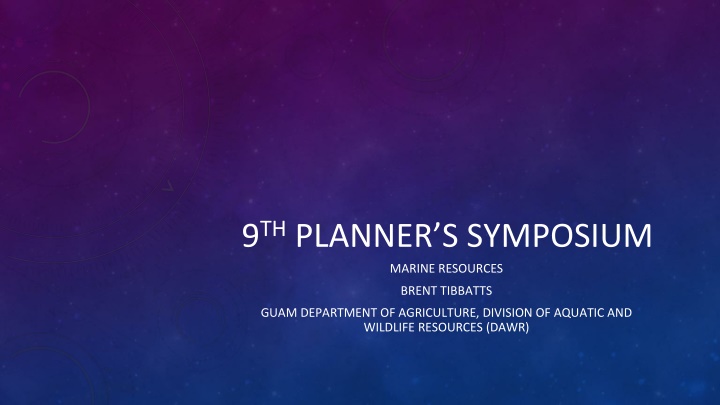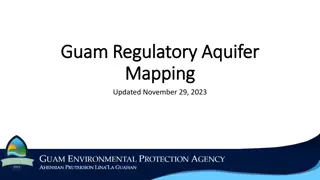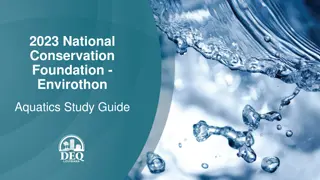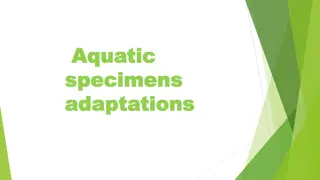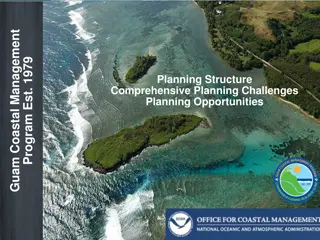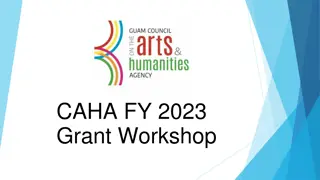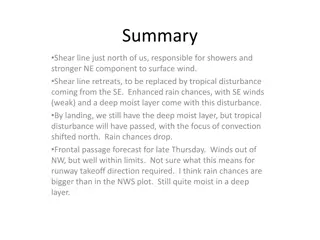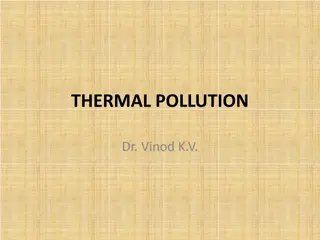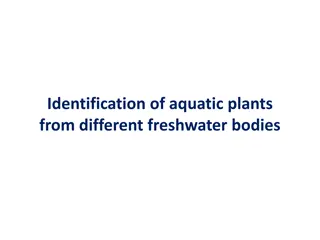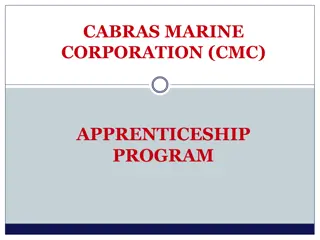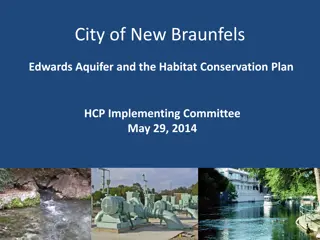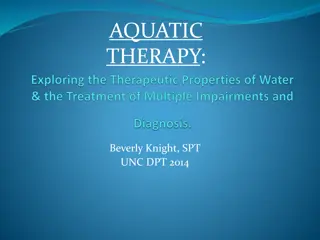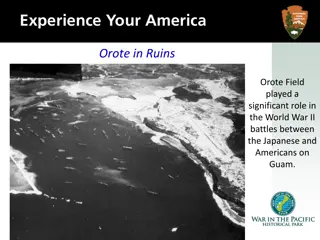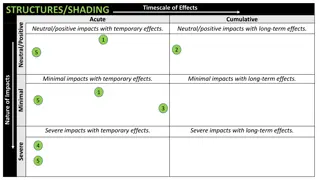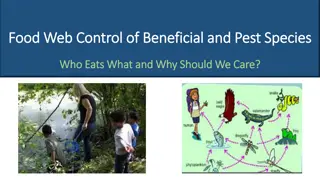Aquatic Resources and Climate Concerns in Guam
Guam boasts diverse aquatic resources including coral reefs, shorelines, wetlands, and rivers, supporting a wide range of marine and freshwater organisms. However, these resources face threats from climate change effects such as rising sea levels, ocean acidification, and coral bleaching. The increasing concern over climate-related impacts on Guam's delicate ecosystems is evident, highlighting the need for conservation efforts and sustainable management practices.
Download Presentation

Please find below an Image/Link to download the presentation.
The content on the website is provided AS IS for your information and personal use only. It may not be sold, licensed, or shared on other websites without obtaining consent from the author.If you encounter any issues during the download, it is possible that the publisher has removed the file from their server.
You are allowed to download the files provided on this website for personal or commercial use, subject to the condition that they are used lawfully. All files are the property of their respective owners.
The content on the website is provided AS IS for your information and personal use only. It may not be sold, licensed, or shared on other websites without obtaining consent from the author.
E N D
Presentation Transcript
9THPLANNERS SYMPOSIUM MARINE RESOURCES BRENT TIBBATTS GUAM DEPARTMENT OF AGRICULTURE, DIVISION OF AQUATIC AND WILDLIFE RESOURCES (DAWR)
WHAT AQUATIC RESOURCES DOES GUAM HAVE? 69 km2 of coral reef and lagoon 151.45 miles of shoreline 85.26 miles of beach Mangrove areas- 191 acres, total 878 acres of wetlands 224 km of rivers- 101, of which 43 reach the ocean Over 5000 species of marine organisms Over 500 species of freshwater organisms.
THREATS TO GUAMS AQUATIC RESOURCES Effects of climate change, to include rising sea levels, rising sea surface temperature, and ocean acidification El Nino/La Nina and typhoons Declining water quality- land based sources of impact Overfishing Invasive species Coral disease/predators
CLIMATE RELATED CONCERNS Rising sea levels lead to increased shoreline erosion and inundation. Loss of property, and potential damage to infrastructure, including roads, power and water transmission. Additionally, Guam law does not allow development within 10 meters of mean high water. This boundary will be changing as sea levels rise. Rising sea surface temperature can lead to coral bleaching and possible mortality. Guam experienced coral bleaching in 2013,2014,2016, and 2017. This lead to the death of between 25% and 100% of coral colonies and sites around Guam. Guam is in a coral bleaching watch for 2024
CLIMATE RELATED CONCERNS Ocean acidification is a lowering of ocean water pH, generally by absorption of excess CO2 in the air. Ocean acidification causes weakening in the skeletal structures of marine organisms that build calcium carbonate skeletons. This includes, but is not limited to, corals, mollusks, some algae, and crustaceans. Heavier than normal rainfall is associated with La Nina conditions in the western Pacific. This can lead to run off and impact water quality. Hotter than normal conditions are associated with El Nino in the western Pacific. This can lead to warmer than normal water conditions, lower than normal tides, and increased storm activity. 2023 was a strong El Nino year.
Island Population (2020 census) Ratio (people/ kilometer) Land Area (km2) Reef Area (km2) Guam 550 69 153,836 2230 Hawaii 16,759 1180 1,455,271 1233 CNMI 459 <50 47,329 947 187 220 49,710 226 American Samoa FSM 701 4340 104,650 24.11 Palau 483 1150 17,930 15.59 Marshalls 134 6110 52,590 8.6
LAND BASED IMPACTS Run-off from streets- can contain sediment and chemicals. Normally non- point source. Run-off from agricultural areas- can contain nutrients, sediment, bacteria. Sediment control or proper tilling can help address. Run-off from construction sites- can contain sediment, chemicals. Sediment controls and timing of construction can help address. These reduce water quality, reduce sunlight to corals, and can facilitate overgrowth of algae on coral reefs Some fish kills associated with run-off. A run-off associated fish kill was reported in Tumon Bay on July 12.
OVERFISHING Guam experiences increased commercial fishing activity beginning in 2007. This led to decreasing numbers of important food fish on Guam s reefs. Lower numbers of herbivores, useful for algal control. Lower numbers of top predators, useful for keeping prey species populations healthy and keep numbers under control. This situation has led DAWR try to develop a Fisheries Management Plan
DEVELOPMENT OF A FISHERIES MANAGEMENT PLAN (FMP) The FMP will be developed using Guam fish data. Life history information collected for 26 species of reef fish, from 9 different sets of data Both fisheries dependent and fisheries independent data sets were used FMP can be used to establish certain thresholds, that once exceeded, can trigger management actions Thresholds can include average size, weight, number caught. These may include size or take restrictions, gear restrictions, and temporal closures. FMP is being developed with input from DAWR, the UOG Marine Lab, and the fishing community.
INVASIVE SPECIES Invasive species can have a variety of impacts on native flora and fauna, including: Vectors for diseases Preying upon native species. Outcompeting native species for resources, e.g. food, shelter, territory Loss of ecological function provided by native species Pathways for invasive species to arrive include: Hull fouling Ballast water Escape from aquaculture facilities Release from pet trade
CORAL DISEASE/PREDATORS Coral predators- primary predator of concern are crown-of-thorns starfish (COTS). Population increases of this predator have been linked to excessive run off. Theory is sediment provides nutrients for larval COTS. Terpiose sponge- bores into and overgrows corals- can become widespread in corals that are already stressed from other environmental factors, i.e. heat stress, poor water quality Drupella snails- feed on coral tissue- can increase in numbers when natural predators have been reduced in numbers, primarily by overfishing Coral disease- several diseases have been found on Guam- black band disease, white band disease, orange band disease. All can cause widespread mortality, and are more lethal when corals are stressed from other environmental factors
TIMING OF IMPACTS Seasonal fish runs- no in water activity- a 4 day period just before the fourth, fifth, ninth, and tenth last quarter moons. An important cultural fishery Coral spawning- no in water activity pre or post spawning- two weeks before July and August full moon. Many species of reef fish spawn based on moon phases.
SOME IMPORTANT DATES Manahakdates for 2024 Box Jellyfish Dates for 2024 Indo-Pacific Man-o-War Dates March 31-April 3 February 2-4 July 28-31 (NOT Portuguese Man-o-Wars!) April 29- May 3 March 2-4 August 27-31 November-February May 28- June 2 April 1-3 September 25-27 August 24-27 May 1-3 October 24-26 September 23-27 May 30-June1 November 23-25 October 22-27 (possible) June 29-July 2 December 22-24
CORAL SPAWNING DATES COURTESY OF THE UOG MARINE LABORATORY 2024 Coral Spawning Periods for Guam Coral Type Month Full Moon Date Spawning Period Soft March March 26 March 19-April 9 Soft April April 24 April 17-May 8 Soft May May 24 May 17-June 7 Hard June June 22 June 15-July 6 Hard July July 22 July 15- August 5 Hard August August 20 August 13-September 3
